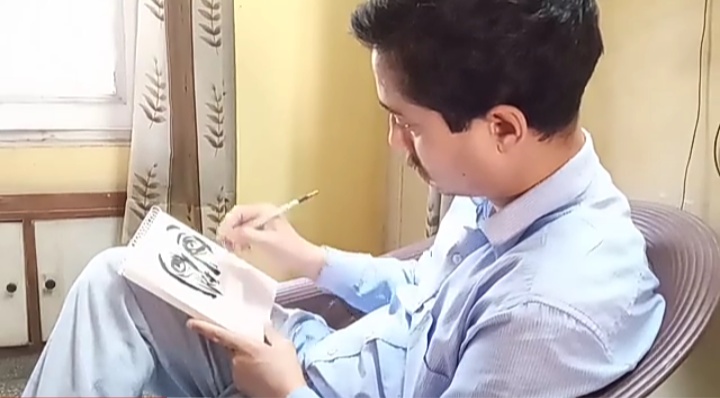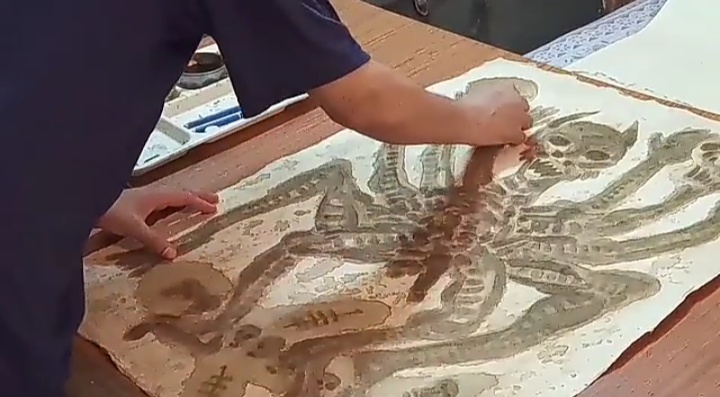Soumen Bhowmick: Art of Humanism
- artamour

- Nov 11, 2020
- 7 min read

A Bengali born in Kolkata, West Bengal, and brought up in Bihar and Delhi, Soumen Bhowmick is a visual artist based in Delhi NCR. He belongs to a family of businessmen and land-owners, from erstwhile East Bengal, Bangladesh. Besides working as an artist, he also plays other roles in the creative world: an independent lecturer on art, active art blogger and a cultural activist. and completed his BFA from the College of Art, New Delhi in 1997, winning the prestigious “Vice-Chancellor’s Award” in his final year.
Soumen held his first solo exhibition “Circus of the Absurd” (2010) at the Lalit Kala Akademi Art Gallery, New Delhi and thereafter held two more solo exhibitions: “Head Tale” (2014) and “Chronicles of V” (2016) at Triveni Gallery, New Delhi. He has exhibited in several group exhibitions in India and participated in the Animamix Biennial, MOCA Shanghai (2009) and the Biennial of Illustrations Bratislava, Slovakia (2011). He has served as an art instructor for creative painting (Sunday Art Class) at NGMA New Delhi and has conducted art workshops since 2009 for both adults and children. He has been involved with academics and teaching with the College of Art, New Delhi, Amity University, Apeejay Stya University, Wigan and Leigh College and South Delhi Women’s Polytechnic. He has also illustrated several children books, book covers, and done illustrations for various dailies and magazines. His paintings are with the collections of Art Alive Gallery, Collector’s Stop Gallery, Delhi Gymkhana Club, AIFACS, Community Against Drunken Driving (CADD), Habiart Foundation and also with private collections in India, Switzerland, Norway and Canada.

My steps dissolve into a space that evaporates into thoughts I do not think . . . – Octavio Paz
1. When did you decide and what prompted you to become an artist? Please give a brief account of your challenges and struggles in your journey as an artist. Any role models?
SB: Well, it all started when I was living with my maternal grandparents in Kolkata. I was part of a big extended family and the joint family provided me with folktales and other stories that fed my imagination. We cooked in clay ovens and I would draw everywhere with the coal and charcoal used for cooking. The entire terrace surface and the walls of the house became my canvas. These initial creative encounters with charcoal and coal paved the way for me to explore the world of drawing and art.
All artists have their share of struggle in their artistic journey. I too have had mine. The struggle began right from my school days when I’d to convince my parents that my solitary interest was art alone and all that I wanted was to become a professional artist. I changed my school to learn art from Manab Kumar Banerjee, who was the art teacher of Raisina Bengali Sr. Sec. School. It was again a struggle to clear the entrance exam to the prestigious College of Art, New Delhi in 1993 and finally join the big league of formal art education. But the real struggle has been after my graduation when I've had relearn art on my own.
The challenge for me as an artist is to be honest with my thoughts and creations – to learn to be a good observer, absorb the unknown around me, and give shape to it on a piece of paper or canvas. During the early days of my creative journey, I was inspired by many artists, both Indian and foreign. But as I started walking alone through the unknown alleys of art, my inspirational spectrum reduced to a few, namely Ganesh Payne, Nandalal Bose, Marc Chagall, Matisse and, most importantly, Picasso. So for me there was not a single idolization of artistic geniuses, but rather a handful of them.
2. What art project(s) are you working on currently? What is your inspiration or motivation for this?
SB: Currently, I am working on two series of drawings and paintings that explore humanity during this pandemic. The series are divided into two parts, namely “Corona Kaal” and “Monochrome Days” .The Corona Kaal series reflect the isolation and suffering I experienced during the pandemic. Monochrome Days, on the other hand, is my understanding of the social, political and economic environment in India which has also impacted my art; I started this series in 2017 and continue to work on it.
I’ve mostly used a monochromatic palette using organic colour and coffee on paper for both these series of works. There are two reasons for this. One, owing to the distress and angst I saw around me and the ordeals faced by our labour force I was pushed into an emotional corner where I did not feel like using colour. The migrant workers and the underprivileged lot of our society faced a very brutal time in terms of food scarcity, lack of medicines, and means of transport to return to their villages and homes. Many of them were compelled to walk home; hundreds died during this pandemic due to various reasons. Two, there was the practical reason that owing to the lockdown I was unable to access regular paint.

By Air, Coffee on Handmade Paper, 2020

Absurd Times, Organic Colour/Coffee on Handmade Paper, 2020

Kingdom of Bones, Coffee on Handmade Paper, 2020

Migrant Dreams, Coffee on Handmade Paper, 2020

Nero, Coffee on Handmade Paper, 2020
Humanity has been my perennial source of inspiration; socio-political elements have been reflected in my earlier series as well. In my first solo exhibition titled “Circus of the Absurd” containing works during the period 2007-10, I tried to explore the strange relationship and eternal conflict between the inner soul which is pure and divine as symbolized by the clown and the heartless physical world as represented by the tigers filled with anger, lust, fear and envy. With both these circumstantial forces at play, at times despair overwhelms us and at other times inner strength and truth win.

Circus of the Absurd, Acrylic, Soft Pastel and Charcoal on Paper, 2008

Throne of the Victor, Acrylic, Soft Pastel and Charcoal on Paper, 2010
My second series “Head Tales”, which I worked on during 2012-16, was based on my personal experience of witnessing street urchins compelled to perform in front of the general public to merely earn a piece of roti and also seeing homeless migrants with punctured dreams. Through my works I vividly portrayed their tales of their hopes, despairs, frustrations and struggles and the dilemmas of present-day society at large.

Saviour, Coloured Ink on Paper, 2011

Magic Head, Coloured Ink on Paper, 2013
3. Contemporary art has become very diverse and multidisciplinary in the last few decades. Do you welcome this trend? Is this trend part of your art practice?
SB: Art and the way we practice it has changed considerably. Change is an inevitable part of the journey of art and I fully endorse these developments. Though I’m not currently incorporating any of these methods or approaches, I would definitely like to experiment and widen my repertoire in the not-too-distant future.
4. Does art have a social purpose or is it more about self-expression?
SB: Personally, I believe art cannot detach itself from its societal responsibilities. The purpose of art should not be to serve any agenda or belief but to reflect contemporary realities – whether good or bad. I do not consciously look for a purpose for my artistic creations. Rather, various social and political issues affecting our lives come knocking at the door of my soul on their own. Cannot escape this! Art for me is pure creative madness, without any logical leash to tame or hold it back. Art gets a purpose when applied in terms of design or commercial art to serve society. Fine art has only one purpose and that is to be an honest reflection of the soul.
5. Where do you create your art (workplace / studio)? What is your process?
SB: My studio is a small corner of my house. Officially, I don’t call it my studio but an abode for my
wandering soul. My studio in Faridabad (in Delhi NCR) is big enough to support my works on paper
but too small for working on canvas. I really don’t yet know my process because I don’t follow any. Nor do I follow any fixed timetable for doing my work. My work starts with drawings and doodles that I create the moment I wake up every morning. Then, if I really feel like creating something on paper, I go for it. Otherwise, I just read books or observe nature around my house or simply listen to news on TV. I spend a lot of time collecting paper clippings from newspapers. But I always keep my sketchbook handy during all these activities.
6. To what extent will the world of art change in the post-Covid period – both in terms of what is created as also the business of art?
SB: This pandemic time is immensely stressful for artists around the world and certainly the way art galleries and institutions have operated previously is changing now. The organization of art business as managed by galleries and art fairs or biennales is now leaning towards the online platform or virtual world. The art created during the pandemic has been more challenging to our senses. Some artists have portrayed the pain, insecurities and vulnerability of humanity more honestly now. Many other artists were compelled to compromise with the materials and size of their work due to the lockdown globally. Several art galleries shut down their operations and most of them now rely on online art exhibitions for survival. Artists have had to now take more in control of their own promotion and propagation.
7. Tell us about any other interest you may have besides your art practice . Does it get reflected
in your art?
SB: I love to maintain a scrapbook of news clippings on various subjects that I have been collecting since 1982. And yes, sometimes, the stories and narratives from these clippings inspire me to create drawings or paintings. One can’t be present everywhere and newspapers and television media are the only sources of information. My art is very much influenced by human behaviour and social and political incidents and events.
(All images are courtesy of Soumen Bhowmick.)
The artamour questionnaire is a regular series of interviews with visual artists across disciplines, who share their views about art, their practice and their worldview on a common questionnaire template. Like, comment, share and subscribe to stay updated.










Comments